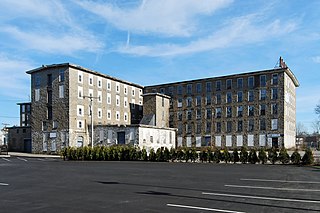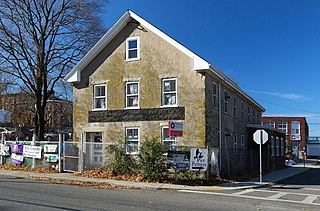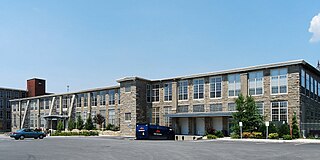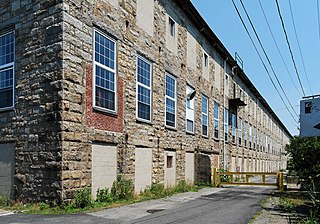
The Boston Manufacturing Company was a business that operated one of the first factories in America. It was organized in 1813 by Francis Cabot Lowell, a wealthy Boston merchant, in partnership with a group of investors later known as The Boston Associates, for the manufacture of cotton textiles. It built the first integrated spinning and weaving factory in the world at Waltham, Massachusetts, using water power. They used plans for a power loom that he smuggled out of England as well as trade secrets from the earlier horse-powered Beverly Cotton Manufactory, of Beverly, Massachusetts, of 1788. This was the largest factory in the U.S., with a workforce of about 300. It was a very efficient, highly profitable mill that, with the aid of the Tariff of 1816, competed effectively with British textiles at a time when many smaller operations were being forced out of business. While the Rhode Island System that followed was famously employed by Samuel Slater, the Boston Associates improved upon it with the "Waltham System". The idea was successfully copied at Lowell, Massachusetts, and elsewhere in New England. Many rural towns now had their own textile mills.

Ironstone is an historic village,, in the township of Uxbridge, Massachusetts, United States. It derived its name from plentiful bog iron found here which helped Uxbridge to become a center for three iron forges in the town's earliest settlement. South Uxbridge has historic sites, picturesque weddings, hospitality, industrial and distribution centers, and the new Uxbridge High School. This community borders North Smithfield, and Burrillville, Rhode Island, and Millville, Massachusetts. South Uxbridge receives municipal services from Uxbridge, for fire, police, EMS, School district, public works, and other services. There is a South Uxbridge fire station of the Uxbridge fire department. Worcester's Judicial District includes Uxbridge District Court. Ironstone appears on the Blackstone U.S. Geological Survey Map. Worcester County is in the Eastern time zone and observes DST.

The Bourne Mill is an historic textile mill on the border between Tiverton, Rhode Island and Fall River, Massachusetts.

The Metacomet Mill, built in 1847 by Colonel Richard Borden for the manufacture of cotton textiles, is the oldest remaining textile mill in Fall River, Massachusetts.

The Border City Mill No. 2 is a historic cotton textile mill at One Weaver Street in Fall River, Massachusetts. Built in 1873, it is the largest surviving element of the once-sprawling Border City Mill complex. It was designed by Josiah Brown, a prominent local designer of mills, and is one of the city's few brick mills. It was listed on the National Register of Historic Places in 1990. It was converted into residences in the 1980s.

Durfee Mills is an historic textile mill complex located at 359-479 Pleasant Street in Fall River, Massachusetts, USA. Developed between 1866 and 1904, it was during its period of development the city's largest and architecturally finest mill complex. Along with the adjacent Union Mills, it is occupied by numerous retail businesses and a restaurant, and is known as the Durfee-Union Mills. The complex was listed on the National Register of Historic Places in 1983.

Sanford Spinning Company is an historic mill complex located on Globe Mills Avenue in Fall River, Massachusetts. It was added to the National Register of Historic Places in 1983, along with the adjacent Globe Yarn Mills #3.

King Philip Mills is an historic cotton mill complex located at 372 Kilburn Street in Fall River, Massachusetts. Developed between 1871 and 1892, it was historically one of the city's largest mills, and its building inventory is still largely complete. The complex was added to the National Register of Historic Places in 1983.

Wampanoag Mills is a historic textile mill complex located at 420 Quequechan Street in Fall River, Massachusetts. Built beginning in 1871, it is a large and well-preserved example of granite textile mill construction. The site was added to the National Register of Historic Places in 1983.

Oliver Chace's Thread Mill is an historic mill building at 505 Bay Street in Fall River, Massachusetts. It is the remains of a much larger complex. The small building was used as an office and later for storage.

Clover Leaf Mills is a historic cotton textile mill complex located at 1 & 21 Father DeValles Boulevard in Fall River, Massachusetts. Begun in 1884, the mill is a good example of 1880s industrial architecture. The site was added to the National Register of Historic Places in 1983.

The Old Colony Iron Works-Nemasket Mills Complex is a historic industrial site located on Old Colony Avenue in the East Taunton section of Taunton, Massachusetts, United States, adjacent to the Taunton River at the Raynham town line. The site was first occupied by the Old Colony Iron Company, which had originally been established in the 1820s as Horatio Leonard & Company. The western part of the complex was sold to Nemasket Mills in 1889. The eastern part was acquired by the Standard Oil Cloth Company. The site was added to the National Register of Historic Places in 1984.

The Cohannet Mill No. 3 is an historic textile mill located at 120 Ingell Street in Taunton, Massachusetts. The mill was built in 1890 and added to the National Register of Historic Places in 2006. It is the only remaining mill of the Cohannet Mills company, founded in 1847 for the manufacture of fine cotton yarns.

The Whittenton Mills Complex is a historic textile mill site located on Whittenton Street in Taunton, Massachusetts, on the banks of the Mill River. The site has been used for industrial purposes since 1670, when James Leonard built an iron forge on the west bank of the river. The first textile mill was built in 1805 and expanded throughout the 19th century. The complex was added to the National Register of Historic Places in 1984, and now contains various small businesses.

Fall River Bleachery is an historic textile bleachery on Jefferson Street in Fall River, Massachusetts.

Laurel Lake Mills is an historic textile mill site located at 951 Broadway in Fall River, Massachusetts.

Border City Mills is an historic textile mill site located at the corner of West Street and Weaver Street in Fall River, Massachusetts.

Davol Mills is a historic textile mill complex located at the corner of Plymouth Avenue and Rodman Street in Fall River, Massachusetts. It was built in 1867 and expanded in 1871. It was added to the National Register of Historic Places in 1983 as part of the Corky Row Historic District The red brick mills are unique in the city, built in the Second Empire style.

Tecumseh Mill No. 1 is a historic cotton mill located at 164 Hartwell Street in Fall River, Massachusetts. It was built in 1866, and added to the National Register of Historic Places in 1983 as part of the Corky Row Historic District. Tecumseh Mills No. 2 and No. 3 were located nearby on Plymouth Avenue, but have since been demolished.

The Manomet Mills are a historic textile mill complex on the north side of New Bedford, Massachusetts. They are located between Riverside Avenue and the Acushnet River, north of Manoment Street and the Whitman Mills. The complex consists of three Classical Revival brick buildings, built between 1903 and 1907. The main building, Mill No. 1, is a 54-bay three story structure that was built in 1903. It is attached to Mill No. 2 (1907), of similar size, by a single story brick structure. The third building is the Mill No. 2 Department Room (1907), a two-story brick building that was originally connected to the other two via overhead bridges, now removed. The mill complex was the main operating site of the Manoment Mill Company, which produced cotton yarn until about 1928. The buildings were sold in that year to the Delaware Rayon Company, which went bankrupt in 1954. Mill No. 2 was then used by the Acushnet Process Company for the manufacture of golf balls, while Mill No. 1 continued to be used for rayon production, a chemically intensive and environmentally hazardous process.























